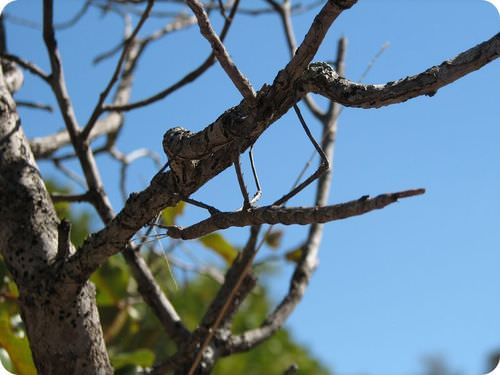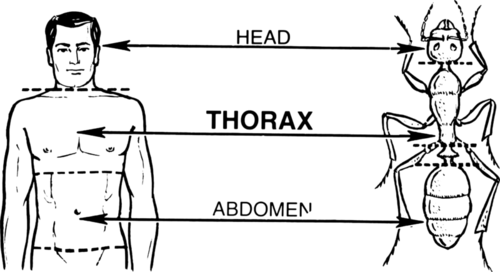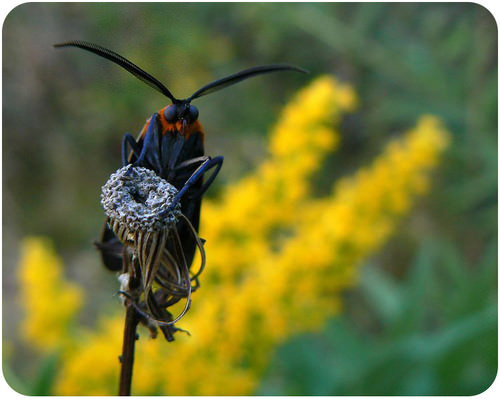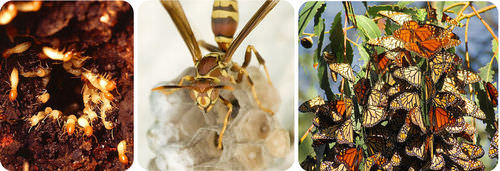9.15 昆虫
Section outline
-
What animals were the first to evolve wings?
::哪些动物是最早进化翅膀的动物?When someone says the word " wing ," you probably think of soaring . Or maybe chicken wings smothered in hot sauce. But insects were actually the first animals to evolve wings.
::当有人说“翅膀”这个词时,你可能会想到飞跃,或者鸡翅被辣酱窒息。但昆虫实际上是最早进化翅膀的动物。What are Insects
::什么是昆虫Insects, with over a million described species , are the most diverse group of animals on Earth. They may be found in nearly all environments on the planet. No matter where you travel, you will see organisms from this group. Adult insects range in size from a minuscule fairy fly to a 21.9-inch-long stick insect ( Figure ).
::昆虫有超过100万个物种,是地球上最多样化的动物群。它们几乎可以在地球上的所有环境中找到。无论你到哪里旅行,你都会看到来自这个群的有机体。成年昆虫的大小从微小仙子苍蝇到21.9英寸长的昆虫(图 ) 。A stick insect, showing how well it blends into its environment. Characteristics of Insects
::昆虫的特点Characteristics of Insects include:
::昆虫的特点包括:-
Segmented bodies with an
exoskeleton
. The outer layer of the exoskeleton is called the
cuticle
. It is made up of two layers. The outer layer, or
exocuticle
, is thin, waxy, and water-resistant. The inner layer is much thicker. The exocuticle is extremely thin in many soft-bodied insects, such as caterpillars.
::外骨骼的外层称为切片。 它由两层组成。 外层, 或外层, 或外层, 薄、 蜡和防水。 内层要厚得多。 外层, 如毛虫等许多软体昆虫中, 外层非常薄 。 -
The segments of the body are organized into three distinct but joined units: a head, a thorax, and an abdomen (
Figure
and
Table
).
::身体的部位分为三个不同但合并的单元:头部、胸部和腹部(图和表)。
A diagram of a human and an insect, comparing the three main body parts: head, thorax, and abdomen. Structure Description Head A pair of antennae, a pair of compound , and three sets of appendages that form the mouthparts. Thorax Six segmented legs and two or four wings. Abdomen Contains most of the digestive, respiratory, excretory, and reproductive structures. -
A
that is divided into a
brain
and a ventral
nerve
cord.
::被分成脑和心神经神经电线 -
Respiration
that occurs without
lungs
. Insects have a system of internal tubes and sacs that oxygen travels through to reach body
tissues
. Air is taken in through the
spiracles
, openings on the sides of the abdomen.
::没有肺的呼吸。昆虫有一个内管和囊囊系统,氧气穿透到人体组织中。空气通过腹部两侧的发孔和开口进入。 -
A closed
, with one long enclosed coiled tube which runs lengthwise through the body, from the mouth to the anus.
::封闭的,有一条长长的内嵌管管,从嘴到肛门,长长地穿透身体,从嘴到肛门。 -
A circulatory system that is simple and consists of only a single tube with openings. The tube pulses and circulates blood-like fluids inside the body cavity.
::一种简单的循环系统,由仅有一个有开口的单管组成,管脉冲和循环体腔内流出类似血液的液体。 -
Various types of movement. Insect movement can include flight, walking, and swimming. Insects were the only
invertebrates
to develop the ability to fly, and this has played an important role in their success. Many adult insects use six legs for walking, and they walk in alternate triangles touching the ground. This allows the insect to walk quickly while staying stable. A few insects have evolved to walk on the surface of the water, like water striders (
Figure
). A large number of other insects also live parts of their lives underwater. Water beetles and water bugs have legs adapted to paddle in the water. Young dragonflies use jet propulsion, sending water out of their back end to move.
::各种运动类型。 昆虫运动可以包括飞行、行走和游泳。 昆虫是发展飞行能力的唯一无脊椎动物, 这在它们的成功中起到了重要作用。 许多成年昆虫用六条腿走路, 并且用其他三角形走在地面上。 这使昆虫在保持稳定的同时能够快速行走。 少数昆虫已经演变成在水面行走, 如水刺( Figure ) 。 许多其他昆虫也在水下生活。 水蜜蜂和水虫的腿可以适应水桨。 幼龙群使用喷气推进, 将水从后端送出, 以移动 。
A water strider utilizing water surface tension to stand on the water. Communication in Insects
::传播昆虫Insects use many different senses for both communicating and receiving information. The types of that are used by various insects are summarized below ( Table ).
::昆虫在沟通和接收信息时使用多种不同感官,各种昆虫使用的类型概述如下(表)。Types of Communication Representative Organisms Description Visual Bioluminescence Fireflies and : Some species produce flashes to attract mates; other species to attract prey . Sound Production By moving appendages Cicadas Loudest sounds among insects; have special to produce sounds. Ultrasound clicks Moths Predation: Produced mostly by moths to ward off bats . Chemical Wide range of insects have evolved chemical communication; chemicals are used to attract, repel, or provide other kinds of information; use of scents is especially well developed in social insects. Moths Antennae of males ( Figure ) can detect pheromones (chemicals released by animals that influence the behavior of others within the same species) of female moths over distances of many miles. Dance Language Honey bees Honey bees are the only invertebrates to have evolved this type of communication; length of dance represents distance to be flown. A yellow-collared scape moth, showing its feathery antennae. Insects are Social
::昆虫是社会性昆虫Social insects, such as termites, ants, and many bees and wasps ( Figure ), are the most familiar social species. They live together in large, well-organized colonies. Only those insects which live in nests or colonies can home. Homing means that an insect can return to a single hole among many other apparently identical holes, even after a long trip or after a long time.
::白蚁、蚂蚁等社会昆虫以及许多蜜蜂和黄蜂(图)是最熟悉的社会物种。它们居住在组织完善的大型聚居区。只有生活在巢穴或聚居区的昆虫才能回家。 霍明意味着昆虫可以在其他许多明显相同的洞中返回一个洞,即使经过长途旅行或长途跋涉。A few insects migrate in groups. For example, the monarch butterfly flies between Mexico and North America each spring and fall ( Figure ).
::例如,君主蝴蝶每年春季和秋季在墨西哥和北美之间飞翔(图)。(left) Damage to this nest brings the workers and soldiers of this social insect, the termite, to repair it. (center) A wasp building its nest. (right) Monarch butterflies in an overwintering cluster. Two Major Groups of Insects
::昆虫两大类Insects are divided into two major groups:
::昆虫分为两大类:-
Wingless: Consists of two orders, the bristle tails and the silverfish.
::无脊椎:由两条命令组成,两条是玻璃尾巴和银鱼。 -
Winged insects: All other orders of insects. They are named below.
::翅膀昆虫:其他所有昆虫的顺序,其名称如下。
Mayflies; dragonflies and damselflies; stoneflies; webspinners; angel insects; earwigs; grasshoppers, crickets, and katydids; stick insects; ice-crawlers and gladiators; cockroaches and termites; mantids; lice; thrips; true bugs, aphids, and cicadas; wasps, bees, and ants; beetles; twisted-winged parasites ; snakeflies; alderflies and dobsonflies; lacewings and antlions; hangingflies (including fleas); true flies; caddisflies; and butterflies, moths, and skippers.
::飞毛腿、虫、虫、虫、虫、虫、虫、虫、虫、虫、虫、虫、虫、虫、虫、虫、虫、虫、真虫、虫、虫、虫、虫、虫、虫、虫、虫、虫、虫、虫、虫、虫、虫、虫、虫、虫、虫、虫、虫、虫、蝇、虫、虫、虫、虫、蝇、虫、虫、虫、虫、虫、虫、虫、虫、虫、虫、、虫、、虫、虫、虫、、、虫、虫、、、虫、虫、、、虫、、、蝇、虫、、、、虫、虫、、、虫、、、虫、虫。Summary
::摘要-
Characteristics of insects include segmented bodies, a system of internal tubes and sacs through which oxygen travels, and a simple circulatory system.
::昆虫的特征包括分块体、氧气穿透的内管和盐囊系统以及简单的循环系统。 -
Insects use many types of communication, including bioluminescence, sounds, and pheromones.
::昆虫使用多种类型的通信,包括生物发光、声音和荧光素。 -
Some insects are social and live in groups.
::有些昆虫是社会性昆虫,属于群体。
Explore More
::探索更多Use the resource below to answer the questions that follow.
::利用以下资源回答以下问题。-
Terrestrial Arthropods: The Conquerors
at
(13:41)
::地面分布图:13:41时的征服者
-
How many times did arthropods invade the land?
::节肢动物入侵了这片土地多少次? -
Describe the rapid underwater movement of the dragonfly larva.
::描述幼虫在水下迅速移动的情况。 -
What arthropod adaptations led to the class Insecta? Which adaptation do you think was key?
::何种节肢动物适应导致昆虫类?你认为哪些适应是关键? -
Where are insect wings the thickest?
::昆虫翅膀最厚的地方在哪里? -
How have flowers taken advantage of the complex eyes of insects?
::花朵如何利用昆虫的复杂眼睛? -
How may the type of food available to arthropods when they first left the sea be connected to present day insects' role as decomposers?
::节肢动物第一次离开海洋时可得到的粮食种类如何与今天昆虫作为分解者的作用联系起来?
Review
::回顾-
What are three key characteristics of insects?
::昆虫的三个主要特征是什么? -
What are two ways in which insects communicate?
::昆虫沟通的两种方式是什么? -
What are the five components of the insect head?
::昆虫头的五个组成部分是什么? -
What are the features of the insect thorax?
::昆虫胸部的特征是什么? -
Name five types of winged insects.
::列出五类翅膀昆虫
-
Segmented bodies with an
exoskeleton
. The outer layer of the exoskeleton is called the
cuticle
. It is made up of two layers. The outer layer, or
exocuticle
, is thin, waxy, and water-resistant. The inner layer is much thicker. The exocuticle is extremely thin in many soft-bodied insects, such as caterpillars.





